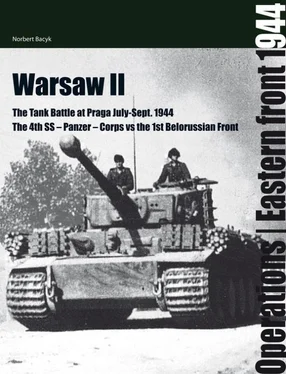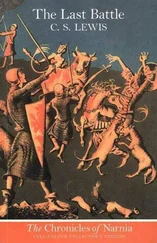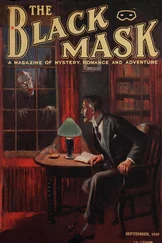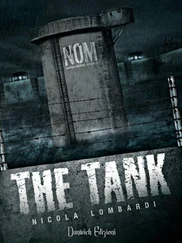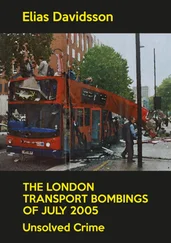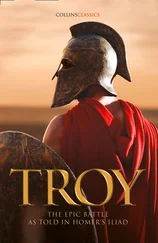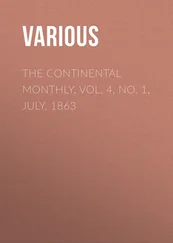It wasn’t until three months later that the Soviet troops cut off Heeresgruppe “Nord” in Kurland.

In all four pictures we find parts of SS-Panzer-Regiment 5 depicted while on the move behind the frontline during July 1944. Note that in the picture (bottom) on page 20, that the Panther’s gun muzzle is covered for the purposes of rain protection as is the muzzle of the machine gun, hardly the case if they thought the enemy were nearby. Note the “clock” on the inside of the machine-gun shield on the half-track in the bottom picture on page 20. This assisted the gunner in orientating the direction toward the correct target to shoot at. The top picture on page 20 depicts a Panther marked 800, ditto bottom photo on page 21, this tank belonged to the commander of the 1st Company from Wiking’s “Panther” Battalion. The half-track depicted on the right side bottom page 21, is a model Sd Kfz 250/3 and is a communication vehicle from the battalion command staff. In the top photo, page 21, we see a Panther, annotated 811, on the move with a couple of Sd Kfz 250/1s, probably part of one of the “Kampfgruppe” near the frontline; note the lack of rain protection on the muzzle. (Petter Kjellander)

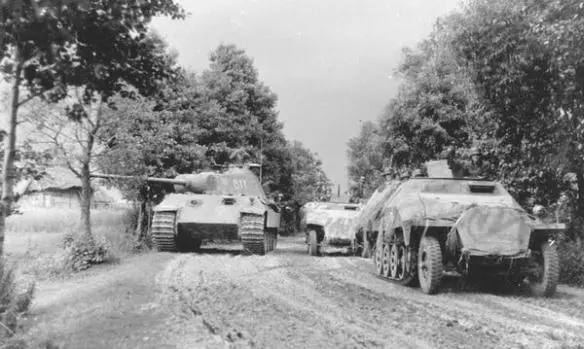
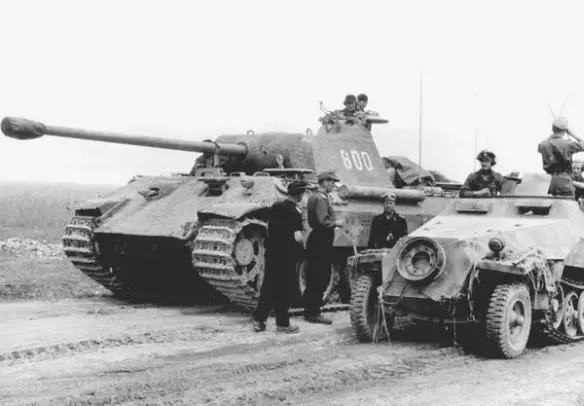
In the meantime, on July 13, the battle-strong 1st Ukrainian Front began its offensive. Its commander, Marshal Ivan Konev had under his command six infantry armies and three tank armies. In addition, he also had at his disposal three individual tank and cavalry corps. After a few days, the attacking troops broke through the frontline, and by July 18, these forces reached the Soviet frontline troops in the Bug River area around Dobraczyn. The weakened German 1st and 4th Panzer-Armies did not manage to halt the Soviet forces, which over the days following July 20, proceeded to cross over the upper Bug River on a broad front with an entire four armies, two of which were tank armies. In addition, prior to July 22, Soviet units encircled and annihilated a couple of enemy divisions a little farther east along the river outside Brody.
In the middle of July 1944, as a result of the 1st Ukrainian Front’s activation and the 1st Belorussian Front’s offensive, which had now been underway for a month, the last line to quiet was on the Eastern Front’s central section was an area east of the Bug River’s central flow. On the German side, the right flank was manned by the 2nd Army (East of Brest) and at the outermost reach of its left flank, by the 4th Panzer-Army (between Brest and Volodmyr Volynskj — the VIII Armee-Korps and the LVI Panzer-Korps). As noted earlier, the 2nd Army at this point had managed to avoid any crushing Soviet onslaughts as they fortunately remained outside the scope of operation “Bagration’s” first phase. Now, with their comrades in the north having suffered such heavy losses, they slowly drew back towards the west. The situation was similar on the 4th Panzer-Army’s left flank. They also occupied positions directly across the 1st Belorussian Front’s, still resting, left flank. The remainder of this German tank army was already engaged in fighting on the Volynia Plateau against the heavy attacks of Marshal Konev’s forces. This situation was completely changed on July 18, when Marshal Rokossovskij strengthened the offensive with the remaining sections of his combat forces. This course of events was to have a decisive effect in connection with Operation Bagration’s coming attacks directed against Warsaw.
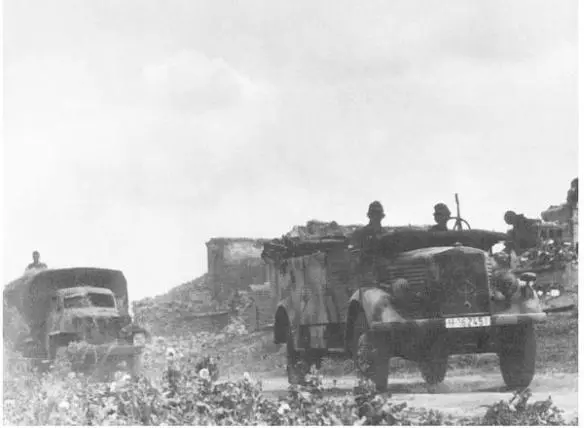
Transport vehicles from the 3rd SS-Panzer-Division “Totenkopf” on the move in July 1944, east of Warsaw. (Leandoer & Ekholm archive)
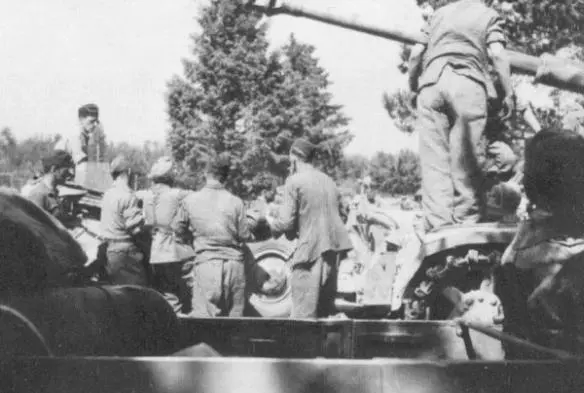
Personnel from Panzer-Regiment 35 carry out maintenance work on a PzKpfw IV ausf H. (Leandoer & Ekholm archive)
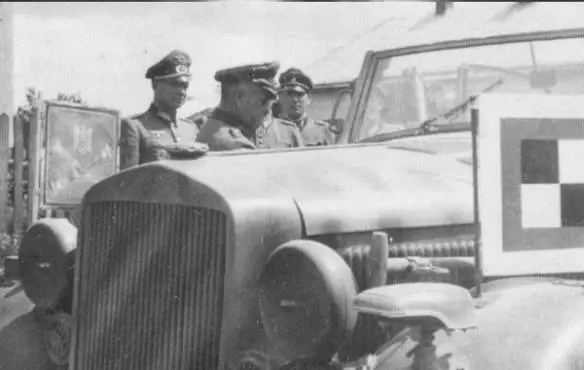
A picture of particular interest! It depicts a m. gl. Einheits-Pkw Kfz 21 which would appear to be the personal transport car of a Field Marshal who is also the commander of the Heeresgruppe. The flag on the car’s left side indicates this, the flag on the right indicates the aforesaid rank. The Field Marshal standing in profile behind the car is none other than Walther Model, Commander of Heeresgruppe “Mitte” in the Summer of 1944. (Leandoer & Ekholm archive)
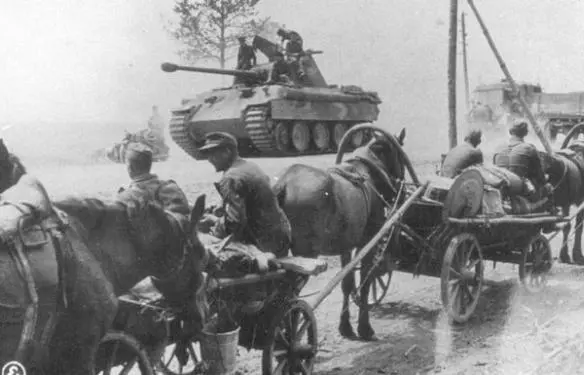
A Panther Sd kFz 171 ausf A passes an infantry unit on the march toward the front. Note the military police in the background on the side of the road. The Panther is from the 3rd SS-Panzer-Division “Totenkopf” in the vicinity of Warsaw, July 1944. (Leandoer & Ekholm archive).
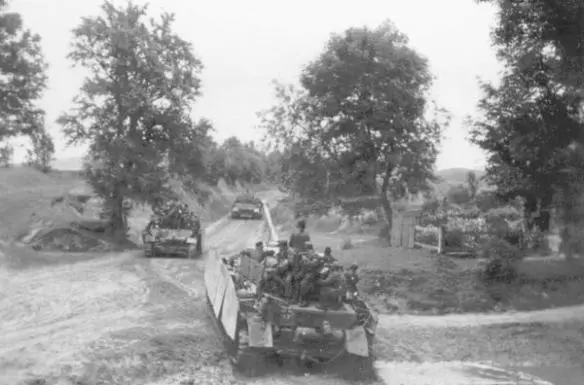
A column of medium tanks PzKpfw IV’s Sd Kfz 161/1.
1 : 2 · The Battles on Warsaw’s distant outskirts
July 18-28, 1944.
On July 17, only two weeks before the Warsaw Uprising was to break out; Warsaw was still a long way behind the Eastern front, which was some 200 kilometres distant. The Polish capital city lay to the rear of the German 2nd Army under the command of General Walther Wieß. At that point in time, troops from this Army began to leave southwest Belorussia flanked to the north by enemy forces under the command of General Rokossovskij. Directly east of General Weiß’s forces, General Pavel Bjelov’s 61st Army began to exert pressure while the following three armies drew forward in the general direction of Hajnówka: General Romanjenko’s 48th Army, General Batov’s 65th Army, and General Lutjinskij’s 28th Army, along with two tank corps, a mechanised corps and a cavalry corps (the 1st Tank Guards Corps, 9th Tank Corps, 1st Mechanised Corps, and the 4th Cavalry Guards Corp). The Germans tried to set up a new defensive position along the Grodno — Hajnówka — Brest line, but on July 17, the opposition wrecked this plan by attacking and breaking through the front in the area around the Białowieża forest. The German command, which already controlled the situation between Kaunas and Brest, had planned to nullify this breach by initiating a number of counterattacks, but the offensive that was launched on the following day from the 1st Belorussian Front’s left flank, totally laid waste to these plans.
It might appear that Marshal Rokossovskij during the fighting up to this point had already made use of the greater part of his combat strength. But in actuality, this was the first time the Soviet forces had set all their reserves into action. The make up of the 1st Belorussian Front’s left flank, which was located along the Prypeć — marsh area — Kovel line, included General Vasil Popov’s 70th Army, General Nikolaj Gusiev’s 47th Army, General Vasil Tjujkov’s 8th Army Guard, Genral Siemjon Bogdanov’s 2nd Tank Army, General Zygmunt Berling’s, 1st Polish Army, General Jusjtjuk’s 11th Tank Corps, General Krjukov’s 2nd Cavalry Guards Corps and General Konstantinov’s 7th Cavalry Guards Corps. All told, these forces mounted to a total of some 416,000 soldiers, 8,355 artillery pieces, mortar and rocket launching ramps, and 1,748 armoured vehicles, (of which 665 were tanks, and 145 tracked artillery vehicles from the 2nd Tank Army). The offensive was supported from the air by 1,465 combat planes from General Fjodor Polunin’s 6th Air Army.
Читать дальше
